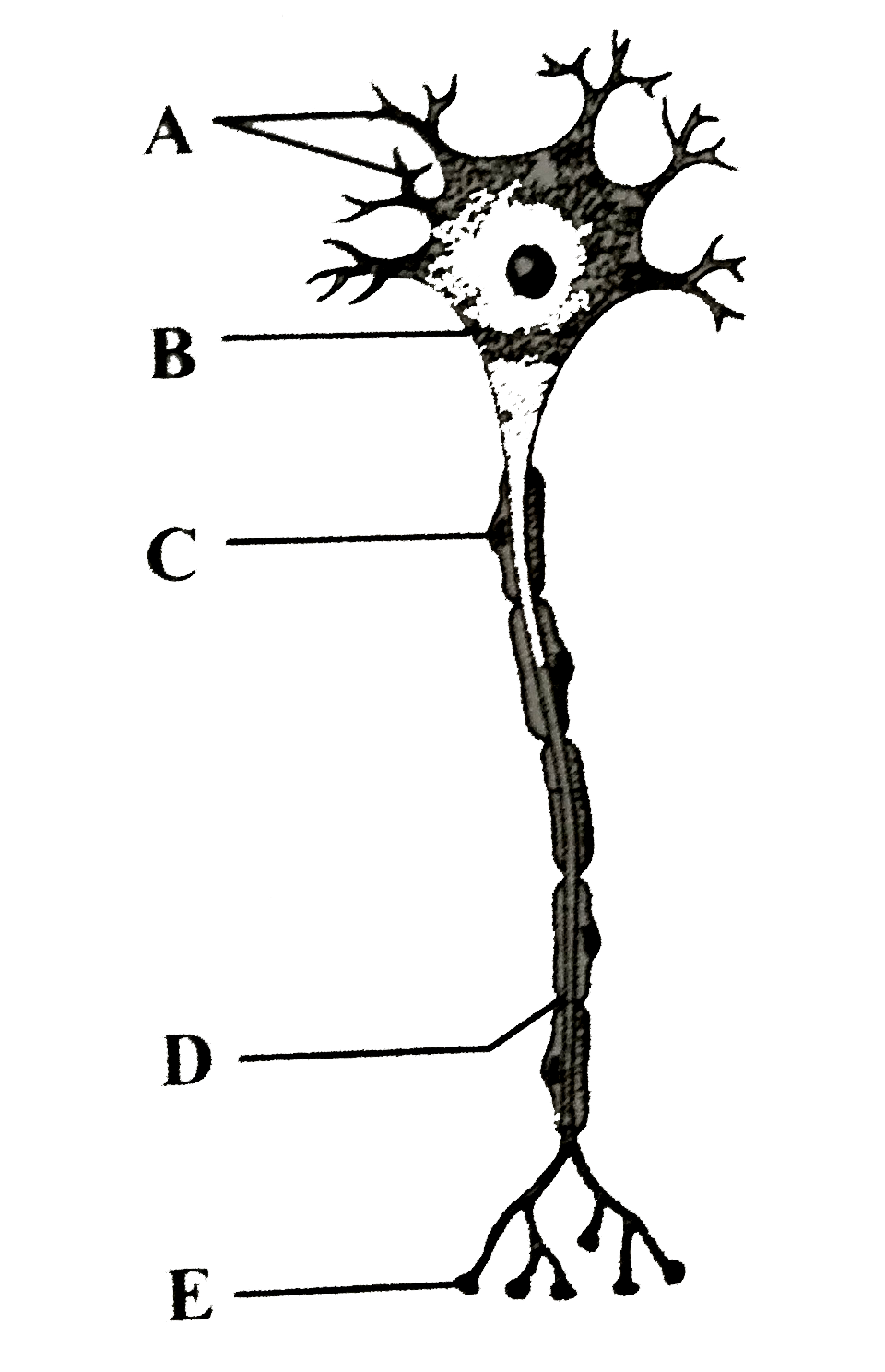Discuss the structure of a neuron.
Step-by-Step Solution to Discuss the Structure of a Neuron
1. Definition of Neuron:
- A neuron is the structural and functional unit of the nervous system. It is responsible for transmitting electrical impulses throughout the body.
2. Basic Structure:
- The neuron consists of three main parts: the cell body (soma), dendrites, and axon.
3. Cell Body (Soma):
- The cell body is irregular in shape, often described as polyhedral. It contains the nucleus and cytoplasm.
- Inside the cell body, there are granular bodies known as Nissl's granules, which are essential for protein synthesis as they contain ribosomes.
4. Dendrites:
- Dendrites are short, branched fibers that extend from the cell body.
- Their primary function is to receive electrical impulses from other neurons and transmit these impulses toward the cell body.
5. Axon:
- The axon is a long, filamentous structure that arises from the cell body.
- It is responsible for transmitting impulses away from the cell body. The distal end of the axon branches out and terminates in synaptic knobs, which contain neurotransmitters.
6. Myelin Sheath:
- The axon is covered by a myelin sheath, which is made up of multiple layers of Schwann cells.
- This myelin sheath is not continuous; it has gaps known as the nodes of Ranvier, which facilitate faster transmission of impulses.
7. Neurilemma:
- The neurilemma is the outermost layer of the Schwann cells that wrap around the axon. It plays a role in the regeneration of the nerve fibers.
8. Nodes of Ranvier:
- These are the gaps between the myelin sheath. They are crucial for the process of saltatory conduction, allowing impulses to jump from one node to the next, increasing the speed of transmission.
Summary:
In summary, a neuron consists of a cell body, dendrites for receiving signals, an axon for transmitting signals, a myelin sheath for insulation, and nodes of Ranvier for rapid signal conduction.
---
- A neuron is the structural and functional unit of the nervous system. It is responsible for transmitting electrical impulses throughout the body.
- The neuron consists of three main parts: the cell body (soma), dendrites, and axon.
- The cell body is irregular in shape, often described as polyhedral. It contains the nucleus and cytoplasm.
- Inside the cell body, there are granular bodies known as Nissl's granules, which are essential for protein synthesis as they contain ribosomes.
- Dendrites are short, branched fibers that extend from the cell body.
- Their primary function is to receive electrical impulses from other neurons and transmit these impulses toward the cell body.
- The axon is a long, filamentous structure that arises from the cell body.
- It is responsible for transmitting impulses away from the cell body. The distal end of the axon branches out and terminates in synaptic knobs, which contain neurotransmitters.
- The axon is covered by a myelin sheath, which is made up of multiple layers of Schwann cells.
- This myelin sheath is not continuous; it has gaps known as the nodes of Ranvier, which facilitate faster transmission of impulses.
- The neurilemma is the outermost layer of the Schwann cells that wrap around the axon. It plays a role in the regeneration of the nerve fibers.
- These are the gaps between the myelin sheath. They are crucial for the process of saltatory conduction, allowing impulses to jump from one node to the next, increasing the speed of transmission.
In summary, a neuron consists of a cell body, dendrites for receiving signals, an axon for transmitting signals, a myelin sheath for insulation, and nodes of Ranvier for rapid signal conduction.
Topper's Solved these Questions
- STRUCTURE ORGANISATION IN ANIMALS -ANIMAL TISSUESBOOK - ICSECHAPTER - STRUCTURE ORGANISATION IN ANIMALS -ANIMAL TISSUESEXERCISE - REVIEW QUESTIONS (SHORT ANSWER TYPE QUESTIONS)
13 Videos
- STRUCTURAL ORGANISATION IN ANIMALS BOOK - ICSECHAPTER - STRUCTURAL ORGANISATION IN ANIMALS EXERCISE - Ncert Exercises (Differentiate Between )
28 Videos
- THE LIVING WORLD BOOK - ICSECHAPTER - THE LIVING WORLD EXERCISE - Ncert Exercises (Differentiate Between )
4 Videos
Similar Questions
Knowledge Check
The given figure shows the structure of a neuron.Select the option that correctly identifies the parts labelled as A to E.
 AABCDENerve fibresCytonSchwann cellNode of RanvierSynaptic knobBABCDEDendritesCytonSchwann cellNode of RanvierSynaptic knobCABCDEDendritesNerve cellSchwann cellSynaptic knobNode of RanvierDABCDEAxonsCytonNerve cellNode of RanvierSynaptic knob
AABCDENerve fibresCytonSchwann cellNode of RanvierSynaptic knobBABCDEDendritesCytonSchwann cellNode of RanvierSynaptic knobCABCDEDendritesNerve cellSchwann cellSynaptic knobNode of RanvierDABCDEAxonsCytonNerve cellNode of RanvierSynaptic knob
Discuss the structure of diamond.
View SolutionDiscuss .the structure of water molecule.
View SolutionDiscuss the structure of ethene.
View SolutionDiscuss the structure of aluminium chloride.
View SolutionDiscuss the structure of interstitial hydrides
View SolutionWhat are atomic solids ? Discuss the structures of diamond and graphite.
View SolutionDiscuss the structures of diamond and graphite and explain the hardness and electrical conductivity of these allotropes on the basis of structures.
View Solution
